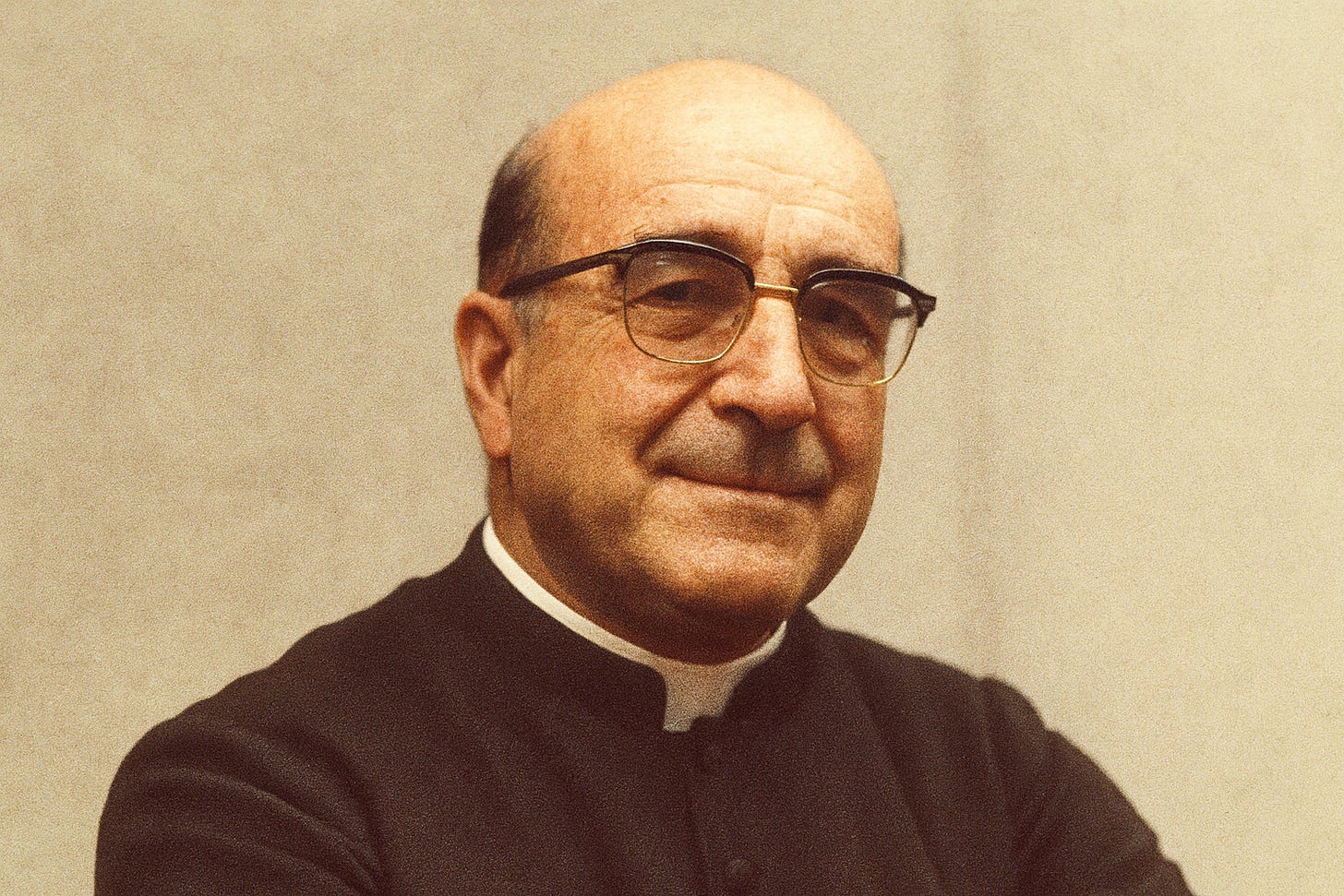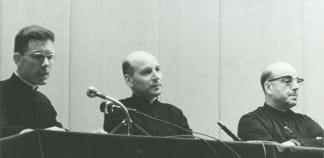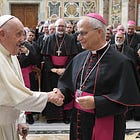'Strong in the Faith': Fr Noël Barbara + a new series on The WM Review
Fr Noël Barbara was one of the early pioneers in the defence of the faith after Vatican II – and yet his writings are not well-known in the Anglosphere.

Fr Noël Barbara was one of the early pioneers in the defence of the faith after Vatican II – and yet his writings are not well-known in the Anglosphere.
Editor’s Notes
The WM Review is launching a new project, serialising the editions of Fr Noël Barbara’s Fortes in Fide.
Fr Noël Barbara was a French priest, and one of the first to take a clear stand against Vatican II. He soon concluded that the post-conciliar claimants to the papacy were not true popes, and he later embraced the so-called “Cassiciacum thesis” of Bishop Guérard des Lauriers.
In 1965, he began publishing a catechetical review named Forts dans la Foi.1 In the 1970s, Fr Peter Morgan – the first English priest ordained by Archbishop Marcel Lefebvre for the SSPX, and now a “sedevacantist” himself – took steps to have an English edition produced. Barbara agreed and funded the launch.
The English version of the review ran until 1993, in three distinct and discrete formats. The first series ran from 1975-9 and was translated by Morgan.
The second ran intermittently in the period 1981-7, under the auspices of the group Union pour la Fidelité. Barbara’s involvement with this group eventually ended, due to differing perspectives. The English version was translated by Maj. J.J. Horton.
The third ran from 1988-93, and was translated by Rama P. Coomaraswamy.
Who was Fr Barbara?
For convenience, much of the following biographical information has been taken from the obituary published in French by the defunct website Catholique Sedevacantiste.2
Fr Barbara was born on Christmas Day, 1910. When asked his name, he amusingly answered “Le père Noël” (Father Christmas). He was of Algerian extraction (a “Pied-noir”) and was ordained in 1938 in Algeria itself.
He was a prisoner of war in the Second World War, where he met the future Fr Georges Vinson – a novice of Fr Vallet’s group, the Congregation of the Parish Cooperators of Christ the King (CPCR).
Vinson was another of the first to oppose the Novus Ordo liturgy (in 1969) and to conclude that the post-conciliar claimants were not true popes.
Barbara eventually returned to mainland France, where he himself joined CPCR in the diocese of Valence. As we have discussed previously, this organisation was focused on delivering five-day versions of St Ignatius’s Spiritual Exercises in a parish setting. The CPCR also provided the SSPX with Fr Ludovic Barrielle, who became Ecône’s spiritual director and “passed on the flame of the Spiritual Exercises of St Ignatius to future priests of the Society of St Pius X.”3
In short, the CPCR, Fr Vallet and the earlier Retreats for Workers movement all had a long-lasting and under-appreciated effect on the “traditionalist” reaction to Vatican II.
Forts dans la foi
Fr Barbara’s early writing career focused on explaining the sacrament of marriage to the laity, as well as fundamental aspects of apologetics (e.g., the immortality of the soul and the existence of God.)
After Vatican II, he founded Forts dans la Foi and published a bimonthly review. For a time, he was associated with Abbé Georges de Nantes of the Contre-reforme catholique.
In 1971, he published an explosive article by the then-Fr Guérard des Lauriers – the first of its kind, at least in French – which argued that attending the Novus Ordo constituted a sin against the faith.
He engaged with many other leading figures in the Catholic resistance at the time, including Fr Joaquín Sáenz y Arriaga and Abbé Coache, with whom he organized several “Marches on Rome” – which included oaths of fidelity to the traditional Latin Mass, and prayer vigils under the windows of Paul VI. He appears to the left of Archbishop Lefebvre in the famous pictures taken with Padre Pio in 1967.4
The lack of authority in the post-conciliar claimants
In 1975, he published La bergerie du Christ et le loup dans la bergerie (“The Sheepfold of Christ and the Wolf in the Sheepfold”), in which he explained the problems of Vatican II as follows:
“Being obliged to limit myself, I shall mention, among all the novelties rejected, only the new Mass, religious liberty, the new ecclesiology, ecumenism, and the new doctrine on the salvation of non-Catholics.”
“I have already said it, but it is good to repeat it. This problem being a matter of faith, the solution can be found only in the light of that same virtue. How is one to proceed? By a very simple reasoning, flowing from the demands of faith.
“Before formulating it, it is essential to recall that faith is a theological virtue which, despite all contrary appearances, leads us to hold the word of God as absolutely true and certain in what it affirms. Indeed, the Apostle states: “Faith is the substance of things hoped for, the evidence of things not seen” (Heb. XI, 1).
“Here, then, is the reasoning of the believer in search of understanding. It rests upon two truths of faith.
First truth of faith. This is clearly taught by St Paul in the epistle to the Romans. There, God commands us to be subject to all authority. Indeed, we read in chapter XIII: “Let every soul be subject to higher powers: for there is no power but from God; and those that are, are ordained of God. Therefore he that resisteth the power, resisteth the ordinance of God: and they that resist purchase to themselves damnation.”
Second truth of faith. I have already emphasised it in presenting the problem: it is God himself who, through the theological virtue of faith, commands believers to resist the orders of these “popes”.
“Reasoning of faith. In the light of these two revealed truths, which he accepts, the believer, “in search of understanding”, seeks to comprehend. He says to himself: God, who is Truth itself, cannot contradict himself. His Son has assured us: “Every kingdom divided against itself shall be made desolate” (Mt. XII, 25).
He offered the following solution to this dilemma:
“… Since the faith assures us that all authority comes from God, and that in resisting established authorities one resists God who established them, we are forced to conclude that in commanding us to resist the ‘popes’ of Vatican II, the faith assures us that these popes are deprived of the authority they ought to have; they are deprived of the very essence of the papacy. In effect, God – who sees all, who knows all – would never command us to resist them, if these popes were clothed with pontifical authority, if they were truly Peter, the Vicars of his Son.”
In 1976, resolving the tension between the Catholic teaching on the papacy and the role of Paul VI in the Vatican II revolution, he accused Paul VI as follows:
“Schismatic, heretic, apostate from the faith, Paul VI has committed spiritual suicide, he left the Mystical Body of Christ of his own accord, and has excommunicated himself.”
He also stated:
“I refuse to ask anything of them [the modernist authorities] because I recognise no power in them so long as they have not publicly retracted their heresies which themselves are public […]
“We shall denounce and fight against the New Mass […]
“[A]s for the sanctions which the present usurpers of the hierarchy might take against us, we hold them to be null and void because […] in those who separate themselves from the Church, there remains absolutely no spiritual power over those who remain within the Church.”
Difficult relations with others
At this time, he maintained relations with both Mgr François Ducaud-Bourget and Archbishop Marcel Lefebvre – although relations with the latter broke down in 1980. After this time, he wrote an open letter to the priests of the SSPX, and wrote a critique entitled Ecône Full Stop.
He also came to break with Abbé de Nantes, based on his policy of sharply criticising the Novus Ordo and accusing Vatican II of schism, whilst also exhorting his adherents to remain in their parishes and recognise the conciliar hierarchy as legitimate. He asked, scathingly:
“How can an intelligent man seriously be a member of the CRC of Abbé de Nantes?”5
Barbara also condemned the 1983 episcopal consecration of Guérard des Lauriers, like many others. Also like others, he considered Guérard des Lauriers to be a man of poor practical judgment. He later changed his position on the consecration, retracted his condemnation and published a defence of Guérard des Lauriers’ actions.
In 1991, he also came to accept Guérard des Lauriers’ “Cassiciacum thesis” as menetioned. He then began collaborating with the Institute Mater Boni Consilii (IMBC).
Conclusion
Some might criticise Barbara for his changes of position, ruptures and denunciations of others in the resistance to Vatican II. He himself replied to these criticisms:
“Only those who do nothing never make mistakes,” says an old proverb. Engaged in the resistance as I have been from the very first hour, and when no one had been prepared for it, missteps were inevitable — and they occurred. As it is said in the Gospel, let the one among my readers who is without sin cast the first stone... Since I became a priest, every time I have become aware of an error, or it has been pointed out to me, God has given me the grace never to settle into it. Always, I have withdrawn from it as quickly as possible, whatever humiliation the reparation might have cost me.”
Some of Barbara’s changes in position are evident as the English editions of Fortes in Fide progress. Nonetheless, the material which they contain is of such value in itself, and such interest extrinsically and historically, that we shall be making them conveniently available to readers of The WM Review.
Whether one considers the changes and tensions to reflect poorly or well on Barbara, and whether one believes he passed from truth to error or error to truth, he remains an important and interesting figure in the post-conciliar period – along with other lesser-known men from the period, including:
Fr Joaquín Sáenz y Arriaga (next on the list)
… and many more.
Archbishop Marcel Lefebvre’s legacy is well-known – at least, parts of it are – but it is certainly worth our while studying and understanding these other men’s words and decisions, even if we do not agree or adopt them for ourselves.
Notes on the texts
They were originally published and typeset by the late James E. McNally, Jr. When he died, his website was rehosted by Griff Ruby.
On McNally’s own site, he wrote:
Nothing on this site is believed subject to copyright laws. In some cases, there never was a copyright. In others, permission from the author to release the file on the Internet has been obtained. In still others, the copyright should have long expired. The site operator does not believe in imposing an "electronic copyright" (the validity of which is extremely dubious in any event) on material not of his own composition.
He stated that the material on his site may be freely distributed, but that his text files should not be modified in any way. His own disclaimers showed great concern about the possibility of bad actors tampering with the material, to the detriment of the faith. Operating as he was at the early stages of the internet, McNally’s text files are not easy to read on modern devices – and some of the files require considerable work in order to make it work on a modern website.
Because of this, we will be reformatting the text itself for The WM Review, whilst ensuring that his text files are accessible to readers and for anyone who fears that the text has been modified.
HELP KEEP THE WM REVIEW ONLINE WITH WM+!
As we expand The WM Review we would like to keep providing free articles for everyone.
Our work takes a lot of time and effort to produce. If you have benefitted from it please do consider supporting us financially.
A subscription gets you access to our exclusive WM+ material, and helps ensure that we can keep writing and sharing free material for all.
(We make our WM+ material freely available to clergy, priests and seminarians upon request. Please subscribe and reply to the email if this applies to you.)
Subscribe to WM+ now to make sure you always receive our material. Thank you!
Read Next:
Follow on Twitter, YouTube and Telegram:
Information about the review itself from here:
Christian Warfare, Foreword
Lefebvre wrote the following in 1990:
“For several years now this slander, a fabrication from start to finish, has been circulating in Italy. I have already refuted it, but lies die hard there is not one word of truth in the page of that magazine you photocopied for me.
“The meeting which took place after Easter in 1967 lasted two minutes. I was accompanied by Fr. Barbara and a Holy Ghost Brother, Brother Felin. I met Padre Pio in a corridor, on his way to the confessional, being helped by two Capuchins.
“I told him in a few words the purpose of m visit: for him to bless the Congregation of the Holy Ghost which was due to hold an extraordinary General my Chapter meeting, like all religious societies, under the heading of aggiornamento (up-dating), meeting which I was afraid would lead to trouble.. Then Padre Pio cried out. ‘Me, bless an archbishop, no, no, it is you who should be blessing me!’ And he bowed, to receive the blessing. I blessed him, he kissed my ring and continued on his way to the confessional...
“That was the whole of the meeting, no more, no less. To invent such an account as you sent me the copy of calls for a satanic imagination and mendacity. The author is a son of the Father of Lies
“Thank you for giving me the chance to tell once more the plain truth."
“Most cordially yours in Christo et Maria,
“+Marcel Lefebvre”
https://www.sspxasia.com/Documents/Archbishop-Lefebvre/Archbishop_Lefebvre_and_Padre_Pio.htm
“Comment quelqu’un d’intelligent peut-il être sérieusement membre de la CRC de M. l’abbé de Nantes ?”







Fascinating material, as always, from The WM Review.
Anxious to hear about the life and thinking of the late Fr. Joaquín Sáenz y Arriaga. Perhaps you can uncover, with certitude, that he was the author of the famous “The Plot Against the Church”.
This is a great idea, I was a subscriber to Fr. Barbara's publication in English: "Fortes in Fides" and I
still have a copy of some of the issues; I also have a copy of his famous book "Le Loup Dan's la Bergerie" (The wolf in the sheepfolf); one of the earliest works explaining the sede-vacantist opinion. In addition, Fr. Barbara's Catechism of Holy Matrimony, published before Vatican II, was considered one of the best explanations of the Sacrament and the duties of the married couple.